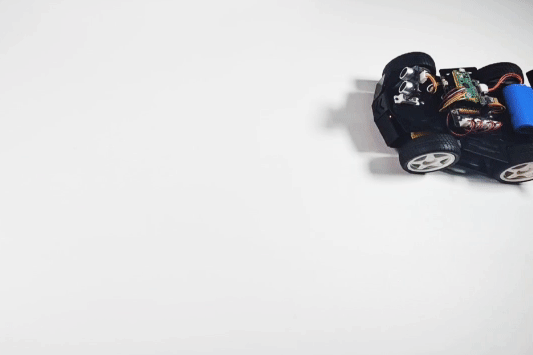3. Objects Follow¶

In this project, Pico-4wd car will follow the object in front of it. For example, if you put your hand in front of Pico 4WD, it will rush towards your hand. And it will also play the advantage of sonar scanning, will judge your hand position and then adjust the forward direction.
Note
The complete script
project_3_follow.pyis in the pathpico_4wd_car\examples\funny_projects.In order to allow the car to move on the ground without the USB cable connected, you need to save this script as
main.pyto Raspberry Pi Pico, see 5. Run Script Offline(Important) for a tutorial.
Below are the steps to implement the object follow function, and you can copy them into Thonny to run them.
1. Sonar scanning
Let the car scan the area between -45° and 45° in front of it. Let the ultrasonic module read the values every 10° and then print out 10 sets of values at once.
import sonar as sonar import motors as car import time try: sonar.set_sonar_scan_config(scan_range=90, step=10) while True: _,_,sonar_data = sonar.sonar_scan() # sonar_data: 0 is block, 1 is pass time.sleep(0.04) # If sonar data return a int, means scan not finished, and the int is current angle status if isinstance(sonar_data,int): continue # only list can go on print(sonar_data) finally: pass
Run the script after copying it into Thonny.
After powering up the Pico 4WD car, you will see the array as shown below,
0means that an obstacle has been detected.[0, 0, 1, 1, 0, 0, 0, 0, 1, 1]
2. Divide the direction
Now to process the scan results. The scan range should be divided into three areas: left, middle and right. After that, determine where the center point of the largest obstacle is located, for example on the left, then let the car go to the left (here just show to the left, do not let the car move).
Let the car stop if the obstacle is too small or there is no obstacle.
import sonar as sonar import motors as car import time def get_dir(data,split_str='0'): # get scan status of 0, 1 data = [str(i) for i in data] data = "".join(data) print("Data: ",data) # Split 1, leaves the object path paths = data.split(split_str) print("Divide the Data: ", paths) # Find the max path max_paths=max(paths) print("Max Path: ",max_paths) # If no object if len(max_paths)<3: return "stop" # Calculate the direction of the biggest one position = data.index(max_paths) # find the biggest object position position += (len(max_paths)-1)/2 # find the middle of the biggest object print("Max Path's Direction: ",position) # Divide the scanning area into three pieces and mark the right one if position < len(data) / 3: return "left" elif position > 2 * len(data) / 3: return "right" else: return "forward" try: sonar.set_sonar_scan_config(scan_range=90, step=10) while True: _,_,sonar_data = sonar.sonar_scan() # sonar_data: 0 is block, 1 is pass time.sleep(0.04) # If sonar data return a int, means scan not finished, and the int is current angle status if isinstance(sonar_data,int): continue # only list can go on direction = get_dir(sonar_data,split_str='1') print("The Car Should Go: ", direction) finally: pass
Run the script after copying it into Thonny.
After powering up the Pico 4WD car, you will see the following data in the Shell. Now look at how this data is explained.
Data: 0011000011 Divide the Data: ['00', '', '0000', '', ''] Max Path: 0000 Max Path's Direction: 5.5 The Car Should Go: forward
Separate the data
0011000011with 1 as a separator to get the array['00', '', '0000', '', ''].The largest obstacle is
'0000'.They are located in the fourth to seventh bits of the data (the first bit is the 0th bit), and that center point is at the 5.5 bit position.
Divide the length of the data (
0011000011) into thirds. Since the length of this data set is 10, those less than 3.3 are on the left side and those greater than 6.6 are on the right side.5.5 is in the middle, then the car should be forward.
3. Follow your hand
Make the Pico 4WD car move in the direction of the obstacle, for example, if there is an obstacle on the left, move to the left.
import sonar as sonar import motors as car import time def get_dir(data,split_str='0'): # get scan status of 0, 1 data = [str(i) for i in data] data = "".join(data) # Split 1, leaves the object path paths = data.split(split_str) max_paths=max(paths) # no object if len(max_paths)<3: return "stop" # Calculate the direction of the biggest one position = data.index(max_paths) # find the biggest object position position += (len(max_paths)-1)/2 # find the middle of the biggest object # Divide the scanning area into three pieces and mark the right one if position < len(data) / 3: return "left" elif position > 2 * len(data) / 3: return "right" else: return "forward" def running(direction,power): if direction == "left": car.move("left", power) elif direction == "right": car.move("right", power) elif direction == "forward": car.move("forward", power) else: car.move("stop") try: MOTOR_POWER = 20 sonar.set_sonar_scan_config(scan_range=90, step=10) while True: _,_,sonar_data = sonar.sonar_scan() # sonar_data: 0 is block, 1 is pass time.sleep(0.04) # If sonar data return a int, means scan not finished, and the int is current angle status if isinstance(sonar_data,int): continue # only list can go on direction = get_dir(sonar_data,split_str='1') running(direction,MOTOR_POWER) finally: car.move("stop")